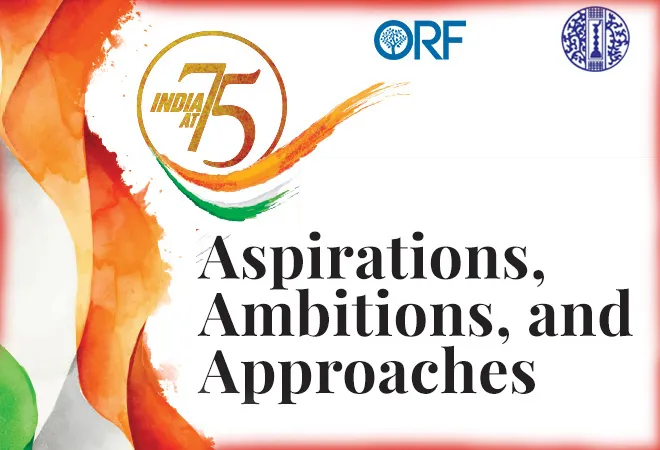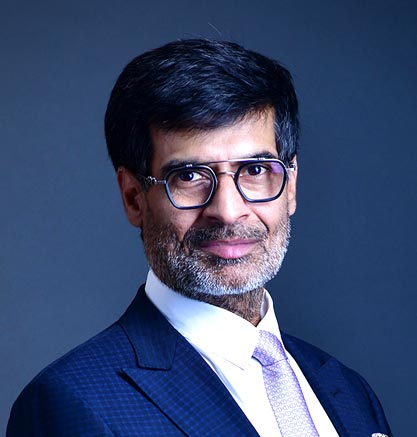-
CENTRES
Progammes & Centres
Location
 This piece is the Editor's Note for the essay series, India@75: Aspirations, Ambitions, and Approaches
This piece is the Editor's Note for the essay series, India@75: Aspirations, Ambitions, and Approaches
If a weary international community—reeling from unanticipated challenges and unprecedented disruptions in the early 21st century—was looking forward to a stabilising start to the 2020s, its hopes were short-lived. COVID-19 continues to weave its way through borders and continents, felling victims and flummoxing governments. Two years down the line, it is increasingly clear that we have to learn to live with the virus, as it shows signs of transitioning to become endemic. A “new normal” where COVID-19 does not cripple communities, countries and whole continents is the future, even as vaccine inequity makes the possibility of more lethal variants imminent.
But even before COVID-19 forced us to radically rethink and redo the way we live our very lives, a certain tiredness had been evident. Generational and geographical shifts in the balance of power, rapid advances in technology-led innovations, and existential global risks like climate change have all strained the capacity of prevailing international norms and institutions. These have left them looking wilted, if not withered. Now, these norms and institutions have all but shattered from the strain of the pandemic. There is no percentage in stating the obvious, yet it must be reiterated: The international community needs new ideas, anchors and torchbearers to reinvigorate globalisation and strengthen global co-operation.
Towards this end, only asinine assessments of a future world order as the century turns 20 would ignore the crucial role of India in shaping this decade, and determining the trajectory of the decades to follow. Our endeavour with this series of essays is to capture the ideas and ethics driving contemporary Indian diplomacy; examine the methods and contours of India’s engagement with the world; and, offer a prognosis of India’s future as a leading power.
Under the rubric of ‘India@75: Aspirations, Ambitions, and Approaches’, ORF has curated 18 essays written by some of the world’s finest minds, representing former heads of state and government, members of parliament, heads of international institutions, leaders from business, and experts from academia and media. Between them, they have studied India’s evolving relationship with new geographies, its engagement with new domains of global governance, and the human imperative that must define India’s rise.
Few predict the path ahead will be easy for India, or that latent and legacy challenges confronting this nation can be ignored. Indeed, most assessments in this volume suggest disquiet and uncertainty. Amrita Narlikar begins her essay with a cautionary note on world affairs. “Multilateralism is facing a crisis of unprecedented proportions,” she writes, “It manifests itself in a fundamental questioning of the very value of multilateralism within countries and deadlocks in negotiations in multilateral organisations.” But this global crisis, she argues, also begets opportunities for India. C. Raja Mohan agrees and asserts that this period of churn offers India the opportunity to shed the temptation to act alone and actively build new coalitions and consensus with other powers. But this will depend, he argues, on how quickly India can restructure its traditional worldview.
As Harsh V Pant writes in this essay, this restructuring is already underway, as “India’s past diffidence in making certain foreign policy choices is rapidly giving way to greater readiness to acknowledge the need for a radical shift in thinking about internal capability enhancement by leveraging external partnerships.”
As the world’s centre of gravity shifts from the Atlantic system, India’s engagement with both emerging and old geographies acquires new salience. And this is where the new external partnerships are actively taking shape. Central among these is the dynamically evolving Indo-Pacific construct which, as Premesha Saha posits, will weave communities, markets and states from the East Pacific to East Africa into one strategic geography. How India adapts its “economic structure” to these realities and implements its “commitment to prevent hegemony in the oceans”, argues Kwame Owino, will determine its ability to lead these new regions.
But shaping new geographies will also require India to manage certain old relationships. The Indo-Pacific should not be seen in isolation—its markets and communities are also rapidly integrating with the Eurasian supercontinent. Steven Blockmans laments that the India-EU relationship has underperformed given its potential to anchor democratic and rules-based governance in greater Eurasia. Solomon Passy and Angel Apostolov boldly make the case for exploring the possibility of a dialogue between NATO and India, indicating just how drastically—and rapidly—the mental maps of the world are morphing.
There is a common thread that binds these analyses: A keen interest in India’s evolving relationship with the US and China. These three nations will, after all, rank among the largest three economies by the middle of this century. The turbulent Twenties will see the dynamics of this power triangle assume centre stage. The US sees India as a partner in its endeavour to neutralise an increasingly aggressive and expansionist China. Jane Holl Lute argues that India “has understood China’s principal strategic aim to replace the United States as the most consequential security power in Asia”. While India’s choices will undoubtedly implicate the balance of power between the US and China, India will most likely chart its own course in international affairs.
ORF Distinguished Fellow Rajeswari Pillai Rajagopalan highlights India’s behaviour in international negotiations on outer space as a primary example. In every significant process—from the UN GGE to the EU CoC—India has argued for greater multilateralism while actively discouraging behaviour that is “inherently destabilising”. I would add India’s engagement on cyber governance, particularly on emerging technologies, to this list. Although technological systems are rapidly unravelling, India has sought to frame rules for its digital economy that both serve its development interests and preserve interdependence. As Trisha Ray writes, “New Delhi must prepare to shape, rather than be shaped, by these shifting geopolitical winds.” Others remind us that much work still needs to be done. Renato Flores urges India to learn lessons from its RCEP withdrawal, shed traditional hesitations, and emerge as a leading advocate for multilateral trade.
India’s most significant contribution to the global commons will be providing sustainable livelihoods to its own people, and its battle against climate change. Indeed, Oommen Kurian & Shoba Suri begin their analysis with the proposition that success or failure in implementing the global SDG agenda is dependent almost wholly on India achieving its own targets. India already produces nearly half of all global vaccines and is a leading voice on IPR reform, as Khor Swee Kheng & K. Srinath Reddy note, making it essential for global health security. India will also be tasked with achieving livelihood goals for itself and the world in a carbon-constrained world, which is why Jayant Sinha argues that India can no longer rely on the ‘farm to industry’ model of development.
Instead, Nilanjan Ghosh asserts that India’s own goal of becoming a US$10 trillion economy, which is both equitable and inclusive, is only possible by following through on the SDG agenda. All of this, according to Adil Zainulbhai, will be powered by India’s already immense digital infrastructure, innovation capabilities and skilled workforce as it leverages the Fourth Industrial Revolution to its advantage. “India’s green transformation,” asserts Mihir Sharma, “will have to be led by the decisions of its people and by the energy of its private sector.”
It is these twin imperatives—achieving sustainable development and the climate change agenda— that make India a very different type of ‘rising power’. Its path to prominence will not be defined by military dominance or coercive economic capabilities. Instead, India’s rise will be characterised by its ability to provide solutions, technologies and finance to emerging communities in urgent need of new models of economic growth and social mobility. It is this ‘new economic diplomacy’, Navdeep Suri believes, that will define India’s foreign policy priorities in the decade ahead.
Underwriting India’s foreign policy will be its civilisational identity as a democratic, open and plural society. Arguably the most abstract of all its foreign policy tools, India’s own ability to retain social cohesion while providing economic growth and development will, as Prime Minister Stephen Harper observes, help “lead the world as a whole to greater prosperity and peace”. Indeed, each essay has this very sentiment at its core—the importance of India’s rise for its own people, its region, and indeed as a model for the world in this century.
We hope these essays will provide an intellectual stimulus to debates and discussions that will undoubtedly contribute to shaping our collective future, examine our contemporary challenges and allow us a moment to learn from the journey so far. The world in the 2020s demands more from us. Indians must be ready to deliver.
The views expressed above belong to the author(s). ORF research and analyses now available on Telegram! Click here to access our curated content — blogs, longforms and interviews.

Samir Saran is the President of the Observer Research Foundation (ORF), India’s premier think tank, headquartered in New Delhi with affiliates in North America and ...
Read More +